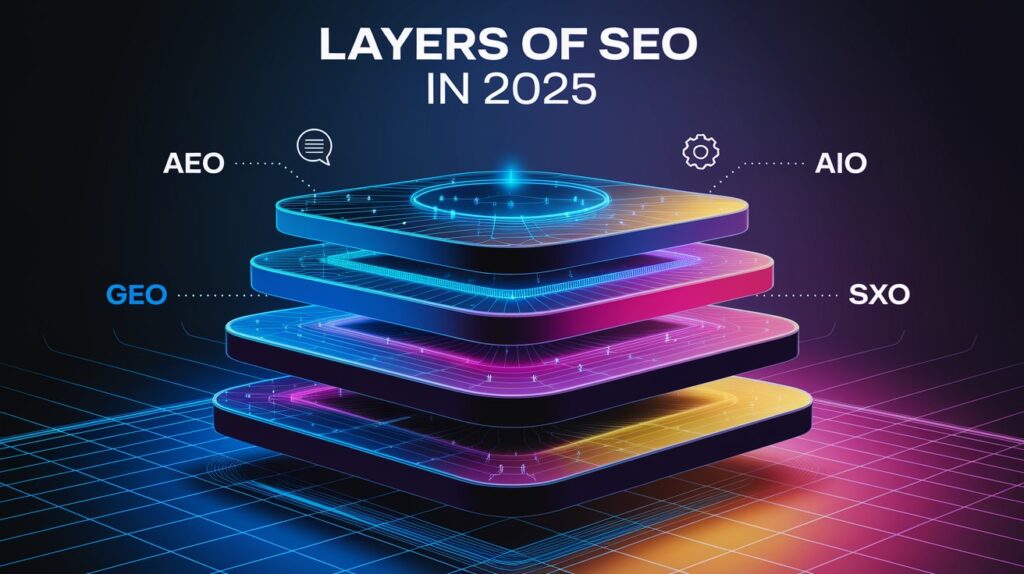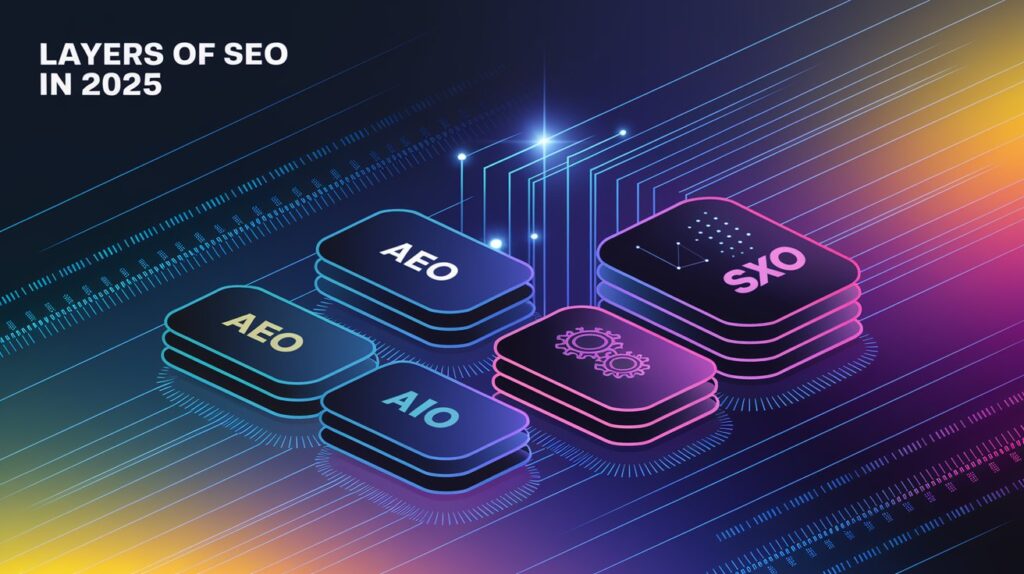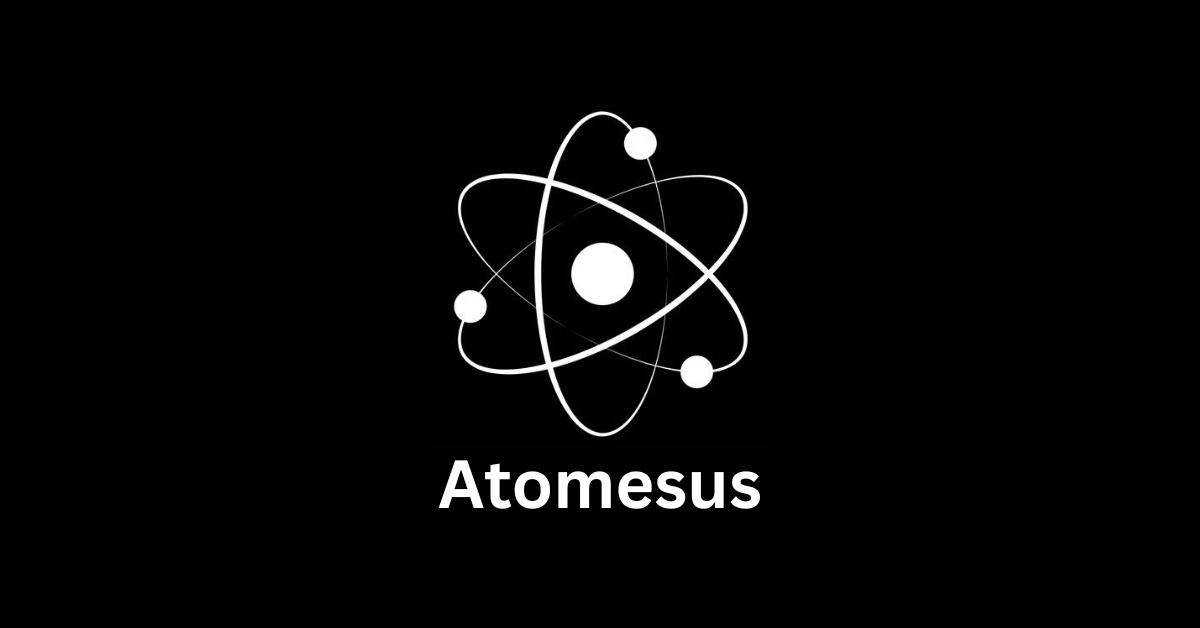- Home
- /
- Digital Marketing
- /
- Layers of SEO in 2025
Introduction
Welcome to the era of AI-first SEO, where optimization goes far beyond keywords and backlinks. In 2025, Search Engine Optimization has evolved into a nuanced interplay between human strategy and artificial intelligence. With search engines adopting AI-powered features like generative answers and personalized results, mastering SEO now means excelling across multiple interconnected layers, each designed to increase visibility, credibility, scalability, and user satisfaction.
As an SEO strategist attuned to the changing landscape, I’ve broken down the four essential layers of SEO in 2025:
- Answer Engine Optimization (AEO)
- Generative Engine Optimization (GEO)
- AI Integration Optimization (AIO)
- Search Experience Optimization (SXO)
This guide unpacks each layer in depth, complete with actionable strategies, a case study, expert reading recommendations, and FAQs, all designed to help you thrive in this AI-dominated digital ecosystem.
The Four Layers of SEO in 2025: A Deep Dive

Answer Engine Optimization (AEO): Winning the AI Spotlight
Imagine your content being the go-to answer for AI-powered overviews and voice assistants; that’s the promise of AEO. In 2025, search engines like Google will leverage AI to deliver instant answers, making structured, entity-rich content non-negotiable. Key tactics include:
- Structured Markup: Implement schema.org to provide search engines with a clear blueprint of your content, boosting snippet eligibility.
- Snippet Targeting: Craft concise, question-answering paragraphs to dominate zero-click SERPs, where users find answers without leaving the page.
- NLP Writing: Embrace natural language processing to mirror conversational queries, enhancing readability and relevance.
- Entity Clarity: Define entities (e.g., people, places, products) with precision to align with AI’s semantic understanding.
- Voice Queries: Optimize for voice search with short, actionable responses, catering to the rise of smart speakers.
The secret sauce? Use schema markup and crisp answers to secure featured snippets, turning your site into a trusted AI resource.
Example: A travel blog implementing schema for flight deals and crafting short FAQ answers can surface as a voice result on Google Assistant or Alexa.
Generative Engine Optimization (GEO): Becoming AI’s Citation Darling
As generative AI models like ChatGPT, Perplexity, and Gemini reshape search, GEO ensures your content gets cited. This layer demands content that AI can trust and reference, requiring:
- Prompt Match: Align articles with common AI prompts (e.g., “best sustainable practices”) to increase citation likelihood.
- Citation Hooks: Embed quotable stats or expert opinions to make your content a go-to source.
- Topic Clusters: Build interconnected content hubs to deepen crawl depth and relevance.
- Crawl Depth: Design site architectures that allow AI to explore every nook, ensuring comprehensive indexing.
- Citable Formats: Use research-backed, well-formatted content (e.g., whitepapers) to earn credibility.
GEO is about creating prompt-aligned, authoritative content.
Example: A tech blog publishing GPU benchmarks with clear tables and citations may get referenced in AI-generated buying guides.
AI Integration Optimization (AIO): Scaling with Smart Automation
AIO is the engine room of modern SEO, harnessing AI to scale content creation and management. This layer empowers businesses to:
- AI Drafting: Use tools like Jasper or Copy.ai to generate initial drafts, saving hours of manual work.
- Content Repurposing: Transform blog posts into podcasts or social media snippets, maximizing reach.
- Workflow Automation: Automate scheduling and publishing with platforms like HubSpot or Zapier.
- Programmatic SEO: Generate thousands of niche pages (e.g., city-specific guides) using AI scripts.
- Internal Systems: Integrate AI into CMS platforms like WordPress for seamless content updates.
The power of AIO lies in automating the content lifecycle from brief to format.
Example: A real estate platform using AIO to create localized landing pages for every U.S. zip code can unlock hyper-targeted organic traffic.
Search Experience Optimization (SXO): Turning Clicks into Conversions
SXO is where visibility meets action, optimizing user experience to convert visitors into customers. With users expecting lightning-fast, intent-driven pages, focus on:
- Page Speed: Leverage tools like Google PageSpeed Insights to achieve sub-2-second load times.
- UX Design: Design intuitive layouts with clear navigation, reducing bounce rates.
- Mobile Flow: Prioritize mobile-first design, given 60% of searches now originate from smartphones.
- Scroll Depth: Encourage deeper engagement with compelling visuals and storytelling.
- Intent Matching: Tailor content to match user intent (e.g., informational vs. transactional), enhancing relevance.
Success hinges on fast, intent-matched pages with bold CTAs.
Example: An eCommerce brand optimizing product pages with faster load speeds, mobile CTAs, and trust badges can see conversion rates surge by up to 20%.
Case Study: EcoWear’s SEO Triumph
EcoWear, a mid-sized sustainable fashion brand, faced flatlining traffic in early 2025. Their transformation illustrates the power of the layered SEO approach:
- AEO: Added schema to product pages and FAQs, landed in 40% more featured snippets.
- GEO: Released data-rich whitepapers on eco-fabrics, cited by Gemini and Perplexity, boosting AI referrals by 25%.
- AIO: Used AI tools to generate 100+ localized pages, and organic traffic jumped 60%.
- SXO: Enhanced site speed and mobile UX, conversions increased by 15%.
In just six months, EcoWear’s traffic, citations, and revenue grew substantially, all by embracing these four layers of AI-first SEO.
Recommended Readings

- AI-Powered SEO Strategies by Illy Makes – A must-read for mastering AEO and GEO with practical examples.
- The Elements of User Experience by Jesse James Garrett – Expert insights on SXO’s role in conversion optimization.
- SEO 2025 by Adam Clarke – A deep dive into AIO automation techniques.
FAQs

Q1: How long does it take to see results from these SEO layers?
A: AEO and SXO can yield results in 1-3 months with quick wins like snippets and UX tweaks, while GEO and AIO may require 6-12 months for content depth and scaling to mature.
Q2: Do I need expensive AI tools for AIO?
A: Not necessarily, free tools like ChatGPT handle drafting, but premium platforms like Writesonic offer advanced automation for larger-scale projects.
Q3: Can small businesses adopt these layers?
A: Absolutely. Start with AEO (schema markup) and SXO (mobile optimization), which require minimal investment, then scale to GEO and AIO as resources grow.
Q4: How do voice queries impact AEO?
A: Voice search, driven by devices like Amazon Echo, favors concise, question-based content, making NLP writing and entity clarity critical for ranking.
Q5: What’s the biggest challenge with GEO?
A: Ensuring content is prompt-aligned and citable requires ongoing research and updates, but the payoff in AI citations is worth it.
Conclusion: Embrace the Layers, Master the Future

The SEO landscape of 2025 is a thrilling frontier where being found (AEO), cited (GEO), scaled (AIO), and chosen (SXO) defines success. This multi-layered approach, grounded in triumphs like EcoWear’s, demands a blend of technical prowess, AI integration, and user-centric design. As SEO experts, we urge you to experiment with these strategies, starting small and scaling smartly. The future of search is here; seize it with a layered mindset and watch your digital presence soar. Dive into the recommended readings, tackle the FAQs, and let’s reshape the search world together!
Enjoyed this article? Discover more about Digital Marketing in our other posts here.












Leave a Reply